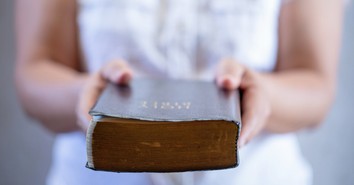What Do We Know about the Magi?

When you think of the Magi, do you remember Christmas performances with children dressed in old bathrobes as they portrayed the Magi, Mary, and Joseph? Perhaps a plastic doll was placed in a homemade wooden box to signify the baby Jesus. The Bible shares the important journey of the special people who traveled from one land to another to see the Messiah. What do we know about the Magi?
Who Were the Magi?
The Oxford Learner’s Dictionary defines the Magi as “(in the Bible) the three wise men from the East who are said to have brought presents to the baby Jesus.”
Because the Magi brought three gifts, later Christian art pictured them as three men, naming them Gaspar (or Caspar), Melchior, and Balthasar. However, some scholars say there may have been more than three men seeking the Messiah—and most note that even if just three visitors arrived, they would have had servant entourages.
These wise men followed a star from the East to find one they called “the King of the Jews,” Jesus Christ. They brought gifts of gold, frankincense, and myrrh to the new king.
One interesting observation is the misconception that the men rode camels, often depicted in drawings and paintings. However, scholars note that they would have used Arabian horses if they had come from northern Arabia.
The Magi studied the Word of God, believed His Word, and obeyed God instead of man.
Both shepherds and wise men went to worship Jesus.
Magi in the Bible
The book of Matthew tells about the birth of Jesus, the Magi who were looking to find Him, and the importance of their gifts for the new child.
“After Jesus was born in Bethlehem in Judea, during the time of King Herod, Magi from the east came to Jerusalem and asked, “Where is the one who has been born king of the Jews? We saw his star when it rose and have come to worship him.” (Matthew 2:1-2 NIV)
Some Sunday School lessons have given the impression that the Magi arrived right after the birth of Jesus. Drawings, paintings, and stories depict the three wise men standing around the newborn child. Nativity scenes often include the Magi. Biblical scholars state that the wise men may have arrived in Bethlehem months or years later.
It is generally agreed that they traveled a great distance to see Jesus. Some traditions imagine they were three men from three continents (Africa, Asia, and Europe), which would have meant traveling over 1,000 miles. However, even if they were from the same territory as the magi mentioned in the Old Testament (see next section), they would have traveled approximately 800-900 miles from the former Babylonian empire to see Christ.
Were the Magi Wise Men or Kings?
The Magi were likely wise men who studied the stars, possibly also interpreting dreams, to advise kings. The Old Testament book of Daniel mentions King Nebuchadnezzar having magi (the word it uses is “Chaldeans”) among advisors in a passage about Daniel and other young men with great understanding and no physical defects being drafted into the king’s service (Daniel 1:3-4). The list included Daniel (Belteshazzar), Hanaiah (Shadrach), Mishael (Meshach), and Azariah (Abednego).
References to magi appear again in Daniel 5, where we learn that King Belshazzar gave a banquet and served drinks in gold and silver goblets that Nebuchadnezzar had taken from the temple in Jerusalem. During this gathering, a human hand appeared and wrote on the wall. At that point, the king called for “the enchanters, astrologers [Chaldeans] and diviners” (Daniel 5:7). While the magic and other wise men came, they could not interpret the writing.
While later Christian traditions would mislabel the Magi as kings, and Christian holidays like Three Kings Day commemorate them, they are depicted in Daniel and other Biblical passages as wise men who advise kings.
There are references to Magi in other ancient texts. Eric Vanden Eykel unpacks many of those references in his book The Magi, affirming that magi are always advisors to kings but not kings themselves.
Bible Verse about the Magi
The New Testament book of Matthew shares the most information about the Magi. However, the Bible begins building the foundation for what the Magi call Jesus, “the King of the Jews,” with the prophecies in Isaiah that describe a promised descendant of David who will reign forever.
Matthew also shares that Jesus was a descendant of Abraham, fulfilling the prophecy about the lineage of the Messiah. The Magi recognized Jesus as the Messiah before most of God’s chosen people in Israel did.
The Old Testament book of Numbers shares the prophecy about a star coming out of Jacob. As Balaam looked out onto the tribes of Israel, camped tribe by tribe, the Bible tells that the Spirit of God came on him.
“I see him, but not now; I behold him, but not near. A star will come out of Jacob; a scepter will rise out of Israel. He will crush the foreheads of Moab, the skulls of all the people of Sheth.” (Numbers 24:17 NIV)
The Bible affirms in various passages that God deserves reverence, like in Psalm 72:11, “May all kings bow down to him and all nations serve him.” The Magi were among the first to give Jesus reverence—artwork often depicts them kneeling as they present precious gifts to Jesus.
Magi's Gifts for Baby Jesus
Picture the gifts that the Magi were carrying to the Messiah. Perhaps the items were tucked into a dirty satchel covered in dust from the road. Maybe each gift had been wrapped delicately to show respect and adoration. A bumpy ride on a hot animal could have made the Magi want to take extra care of the presents.
The gifts prepared and presented to Jesus were gold, frankincense, and myrrh.
Gold is a precious metal used specifically because of its color and shiny appearance. Various uses for gold throughout history include ornaments, jewelry, and idols. Biblical scholars relate the gold to the royalty of Jesus.
Frankincense is a fragrance made from trees in Arabia and India. This item is related to the divinity of Jesus. When the Magi offered frankincense to Jesus, they acknowledged Him as the high priest who was fully man and fully God.
Myrrh is an antiseptic anointing oil made from thorn bushes in Ethiopia and Arabia. Myrrh is also used as an embalming fluid. Myrrh is said to represent the humanity of Jesus. Born of a virgin, yet Son of God. Consider the emotions of everyone gathered as the Magi presented the gifts of gold, frankincense, and myrrh.
Photo Credit: © Getty Images/Vectorgraphics

Melissa is the author of Licky the Lizard and Grumpy the Gator. Her passions are helping in the community and church. Melissa is an Elder, Deacon, and Stephen Minister.
Follow Melissa on Facebook, Twitter, Pinterest, and at https://www.melissaghenderson.
This article is part of our larger Christmas and Advent resource library centered around the events leading up to the birth of Jesus Christ. We hope these articles help you understand the meaning and story behind important Christian holidays and dates and encourage you as you take time to reflect on all that God has done for us through His Son, Jesus Christ!
What Is Christmas? It's History, Origin, and Traditions
The History and Origin of Santa Claus
Christmas Prayers and Blessings
The Beautiful Meaning and Purpose of Advent
Advent Prayers
Advent Wreath & Candles Meaning
The History and Meaning of the Advent Calendar
Originally published November 03, 2023.







